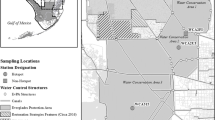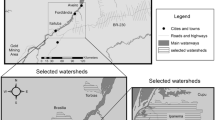Abstract
A partial and gradual transfer of natural and anthropogenic mercury (Hg) accumulated over time in boreal forest soils is the principal origin of Hg contamination of the aquatic organisms living in northern Québec reservoirs. After a decade or more of flooding, little structural change is evident in flooded soils, with the exception of those eroded on the banks of the reservoirs. In non-eroded flooded soils, both the total carbon (C) and Hg burdens in the humic horizon of the podzolic soils and in the entire organic layer of the peatland appear to remain stable through time. The major change in the Hg biogeochemistry in northern soils after their impoundment is represented by the progressive methylation of their initial inorganic Hg content, which reaches approximately 10% and 30% after 13 years for peatlands and podzolic soils, respectively. Once Hg is methylated in the soils, no net demethylation can be clearly observed during winter periods or from one year to the next over the first 13 years of flooding. Low concentrations of dissolved methylmercury (MeHg) (in the few tenths of ng L-1 range) in the reservoirs are indicative of the important dilution of the fraction of this compound which is readily transferred from surface layers of flooded soils to the water column of the reservoirs. In order to explain the rapid Hg contamination of the entire food chain of the reservoirs, one should first take into account that Hg-rich organic particles of the flooded soils represent a source of food for organisms at the base of the aquatic food chain. Insects ingest Hg while burrowing as larvae in the surface of the flooded soils, and zooplankton do so while feeding on particles at the flooded soil-water interface. Moreover, the rapid erosion of the organic horizon of the soils situated in shallow and exposed zones of the reservoirs leads to a higher bioavailability of Hg-rich particles to filter feeding invertebrates. Although phytoplankton production as such does not appear to clearly contribute to the high bioaccumulation of Hg in higher organisms of the reservoirs, the sedimentation of autochthonous particles at the flooded soil-water interface promotes bacterial activity in the biofilm which in turn entrains an additional methylation of the Hg present in the surface layer in which invertebrates often feed. In addition to the initial release of Hg from the flooded soils, processes of active Hg methylation in the biofilm and efficient mechanisms of bioaccumulation of the pollutant by invertebrates must be invoked to explain the Hg contamination of the aquatic organisms of northern reservoirs.
Access this chapter
Tax calculation will be finalised at checkout
Purchases are for personal use only
Preview
Unable to display preview. Download preview PDF.
Similar content being viewed by others
Editor information
Editors and Affiliations
Rights and permissions
Copyright information
© 1999 Springer-Verlag Berlin Heidelberg
About this chapter
Cite this chapter
Lucotte, M., Montgomery, S., Bégin, M. (1999). Mercury Dynamics at the Flooded Soil-Water Interface in Reservoirs of Northern Québec: in Situ Observations. In: Lucotte, M., Schetagne, R., Thérien, N., Langlois, C., Tremblay, A. (eds) Mercury in the Biogeochemical Cycle. Environmental Science. Springer, Berlin, Heidelberg. https://doi.org/10.1007/978-3-642-60160-6_9
Download citation
DOI: https://doi.org/10.1007/978-3-642-60160-6_9
Publisher Name: Springer, Berlin, Heidelberg
Print ISBN: 978-3-642-64282-1
Online ISBN: 978-3-642-60160-6
eBook Packages: Springer Book Archive




